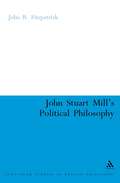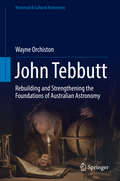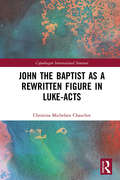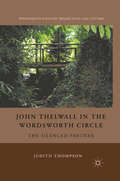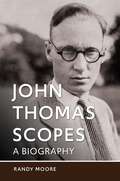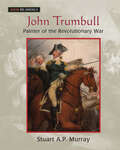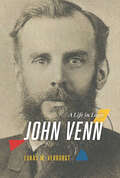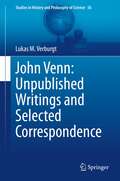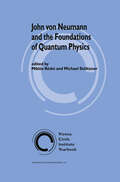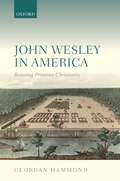- Table View
- List View
John Stuart Mill's Political Philosophy: Balancing Freedom And The Collective Good (Continuum Studies in British Philosophy)
by John R. FitzpatrickIn the aftermath of the terrorist attacks of September 11, 2001, the philosophy of John Stuart Mill has never been more relevant. Can we reconcile individual liberty with the demands of the common good? John Fitzpatrick argues that, properly understood, Mill's liberal utilitarianism can indeed support a system of rights rich enough to guarantee individual liberty. Combining fresh interpretations of Mill's writings on ethics, politics, and political economy with the historical Mill that can found in his autobiography, the book will be of substantial interest to a wide audience.
John Sullivan Dwight: The Life and Writings of Boston's Musical Transcendentalist
by Bill F. FaucettJohn Sullivan Dwight (1813-93) was, for much of the nineteenth century, America's leading music critic. Born into a musical family and educated at several premier Boston schools, he fell under the spell of New England Transcendentalism and befriended Ralph Waldo Emerson, Elizabeth Palmer Peabody, Margaret Fuller, George Ripley, and others of a similarly progressive mindset. Dwight resided at the socialist/utopian community of Brook Farm where he learned the art of journalism and wrote on many topics--Transcendentalism, of course, but especially on music and musical performance. After the demise of Brook Farm and several years as a journeyman writer, Dwight launched Dwight's Journal of Music: A Paper of Art and Literature in 1852. It was a newspaper that firmly established him as a serious music critic and in its time spoke to America's growing appetite for art music. By charting Dwight's relationships with other writers, musicians, and thinkers, as well as his evolution into a powerful and persuasive writer in his own right, this book situates his story in its nineteenth century and Transcendental contexts and provides the first thorough account of music and the arts at Brook Farm. Dwight's enormous body of essays, reviews, translations, correspondence, and other various writings are illuminated in this biography and reveal the indelible influence Dwight's Journal had on music criticism--the impacts of which resonate today.
John Sullivan Dwight: The Life and Writings of Boston's Musical Transcendentalist
by Bill F. FaucettJohn Sullivan Dwight (1813-93) was, for much of the nineteenth century, America's leading music critic. Born into a musical family and educated at several premier Boston schools, he fell under the spell of New England Transcendentalism and befriended Ralph Waldo Emerson, Elizabeth Palmer Peabody, Margaret Fuller, George Ripley, and others of a similarly progressive mindset. Dwight resided at the socialist/utopian community of Brook Farm where he learned the art of journalism and wrote on many topics--Transcendentalism, of course, but especially on music and musical performance. After the demise of Brook Farm and several years as a journeyman writer, Dwight launched Dwight's Journal of Music: A Paper of Art and Literature in 1852. It was a newspaper that firmly established him as a serious music critic and in its time spoke to America's growing appetite for art music. By charting Dwight's relationships with other writers, musicians, and thinkers, as well as his evolution into a powerful and persuasive writer in his own right, this book situates his story in its nineteenth century and Transcendental contexts and provides the first thorough account of music and the arts at Brook Farm. Dwight's enormous body of essays, reviews, translations, correspondence, and other various writings are illuminated in this biography and reveal the indelible influence Dwight's Journal had on music criticism--the impacts of which resonate today.
John Tebbutt: Rebuilding and Strengthening the Foundations of Australian Astronomy (Historical & Cultural Astronomy)
by Wayne OrchistonThis book marks the centennial of Tebbutt's death with a major biographical account surveying his scientific contributions to astronomy, prefaced with a foreword by Sir Patrick Moore. During the second half of the nineteenth century, Tebbutt was Australia's foremost astronomer. He devoted his time and funds to astronomy, and built a truly international reputation that far surpassed Australia's leading professional astronomers of the day. This book marks the centennial of Tebbutt's death with a major biographical account. Tebbutt's remarkable record of achievement extends over more than half a century.Orchiston's book covers the whole of Tebbutt's career, from his yearly observatory reports and comet discoveries to his time as the first president of Sydney's branch of the British Astronomical Association.
John the Baptist as a Rewritten Figure in Luke-Acts
by Christina Michelsen ChauchotJohn the Baptist as a Rewritten Figure in Luke-Acts compares the Gospel of Luke’s account of John’s ministry with those of Matthew, Mark, and John to make the case for the hypertextual relationship between the synoptic gospels. The book is divided into three parts. Part I situates the Gospel of Luke within the broader context of biblical rewritings and makes the general case that a rewriting strategy can be detected in Luke, while Parts II and III combined offer a more detailed and specific argument for Luke’s refiguring of the public ministry of John the Baptist through the use of omitted, new, adapted, and reserved material. While the "two source hypothesis" typically presupposes the independence of Luke and Matthew in their rewritings of Mark and Q, Chauchot argues that Luke was heavily reliant on Matthew as suggested by the "L/M hypothesis". Approaching the Baptist figure in the synoptic gospels from a literary-critical perspective, Chauchot examines "test cases" of detailed comparative analysis between them to argue that the Gospel of Luke makes thematic changes upon John the Baptist and is best characterized as a highly creative reshaping of Matthew and Mark. Making a contribution to current research in the field of New Testament exegesis, the book is key reading for students, scholars, and clergy interested in New Testament hermeneutics and Gospel writing.
John the Baptist as a Rewritten Figure in Luke-Acts
by Christina Michelsen ChauchotJohn the Baptist as a Rewritten Figure in Luke-Acts compares the Gospel of Luke’s account of John’s ministry with those of Matthew, Mark, and John to make the case for the hypertextual relationship between the synoptic gospels. The book is divided into three parts. Part I situates the Gospel of Luke within the broader context of biblical rewritings and makes the general case that a rewriting strategy can be detected in Luke, while Parts II and III combined offer a more detailed and specific argument for Luke’s refiguring of the public ministry of John the Baptist through the use of omitted, new, adapted, and reserved material. While the "two source hypothesis" typically presupposes the independence of Luke and Matthew in their rewritings of Mark and Q, Chauchot argues that Luke was heavily reliant on Matthew as suggested by the "L/M hypothesis". Approaching the Baptist figure in the synoptic gospels from a literary-critical perspective, Chauchot examines "test cases" of detailed comparative analysis between them to argue that the Gospel of Luke makes thematic changes upon John the Baptist and is best characterized as a highly creative reshaping of Matthew and Mark. Making a contribution to current research in the field of New Testament exegesis, the book is key reading for students, scholars, and clergy interested in New Testament hermeneutics and Gospel writing.
John the Pupil: A Novel
by David FlusfederThe extraordinary new novel from David Flusfeder chronicles a pilgrimage to Rome made by three young men with a secret burden. But they will meet with temptation along the way…
John the Theologian and his Paschal Gospel: A Prologue to Theology
by John BehrThis study brings three different kinds of readers of the Gospel of John together with the theological goal of understanding what is meant by Incarnation and how it relates to Pascha, the Passion of Christ, how this is conceived of as revelation, and how we speak of it. The first group of readers are the Christian writers from the early centuries, some of whom (such as Irenaeus of Lyons) stood in direct continuity, through Polycarp of Smyrna, with John himself. In exploring these writers, John Behr offers a glimpse of the figure of John and the celebration of Pascha, which held to have started with him. The second group of readers are modern scriptural scholars, from whom we learn of the apocalyptic dimensions of John's Gospel and the way in which it presents the life of Christ in terms of the Temple and its feasts. With Christ's own body, finally erected on the Cross, being the true Temple in an offering of love rather than a sacrifice for sin. An offering in which Jesus becomes the flesh he offers for consumption, the bread which descends from heaven, so that 'incarnation' is not an event now in the past, but the embodiment of God in those who follow Christ in the present. The third reader is Michel Henry, a French Phenomenologist, whose reading of John opens up further surprising dimensions of this Gospel, which yet align with those uncovered in the first parts of this work. This thought-provoking work brings these threads together to reflect on the nature and task of Christian theology.
John the Theologian and his Paschal Gospel: A Prologue to Theology
by John BehrThis study brings three different kinds of readers of the Gospel of John together with the theological goal of understanding what is meant by Incarnation and how it relates to Pascha, the Passion of Christ, how this is conceived of as revelation, and how we speak of it. The first group of readers are the Christian writers from the early centuries, some of whom (such as Irenaeus of Lyons) stood in direct continuity, through Polycarp of Smyrna, with John himself. In exploring these writers, John Behr offers a glimpse of the figure of John and the celebration of Pascha, which held to have started with him. The second group of readers are modern scriptural scholars, from whom we learn of the apocalyptic dimensions of John's Gospel and the way in which it presents the life of Christ in terms of the Temple and its feasts. With Christ's own body, finally erected on the Cross, being the true Temple in an offering of love rather than a sacrifice for sin. An offering in which Jesus becomes the flesh he offers for consumption, the bread which descends from heaven, so that 'incarnation' is not an event now in the past, but the embodiment of God in those who follow Christ in the present. The third reader is Michel Henry, a French Phenomenologist, whose reading of John opens up further surprising dimensions of this Gospel, which yet align with those uncovered in the first parts of this work. This thought-provoking work brings these threads together to reflect on the nature and task of Christian theology.
John Thelwall: Radical Romantic And Acquitted Felon (The Enlightenment World #11)
by Steve PooleJohn Thelwall was a Romantic and Enlightenment polymath. In 1794 he was tried and acquitted of high treason, earning himself the disdainful soubriquet 'acquitted felon' from Secretary of State for War, William Windham. Later, Thelwall's interests turned to poetry and plays, and was a collaborator and confidant of Wordsworth and Coleridge.
John Thelwall in the Wordsworth Circle: The Silenced Partner (Nineteenth-Century Major Lives and Letters)
by J. ThompsonIn this book, Judith Thompson restores a powerful but long-suppressed voice to our understanding of British Romanticism. Drawing on newly discovered archives, this book offers the first full-length study of the poetry of John Thelwallas well as his partnership with Samuel Taylor Coleridge and William Wordsworth.
John Thelwall: Radical Romantic and Acquitted Felon (The Enlightenment World)
by Steve PooleJohn Thelwall was a Romantic and Enlightenment polymath. In 1794 he was tried and acquitted of high treason, earning himself the disdainful soubriquet 'acquitted felon' from Secretary of State for War, William Windham. Later, Thelwall's interests turned to poetry and plays, and was a collaborator and confidant of Wordsworth and Coleridge.
John Theophilus Desaguliers: A Natural Philosopher, Engineer and Freemason in Newtonian England
by Audrey T. CarpenterJohn Theophilus Desaguliers made his mark on the eighteenth century in several diverse ways. He was an assistant to Sir Isaac Newton and later elucidated the difficult concepts of Newtonian physics in private lectures. He was a member of the Royal Society, and was presented with the Society's highest honour, the Copley Medal, no less than three times. He was a pioneering engineer: the water supply of Edinburgh, the ventilation of the Houses of Parliament and the first Westminster Bridge all owed him a debt. In a different sphere, Desaguliers became the third Grand Master of the Grand Lodge of the Freemasons which was founded in 1717. He is remembered worldwide for his seminal influence during those early days of Freemasonry. He also wrote poetry and had an influential circle of patrons, including George I and Frederick, Prince of Wales (whom he initiated as a Mason at a specially convened lodge at Kew). This biography, based on original research, describes a charismatic character who was a major figure of his age.
John Theophilus Desaguliers: A Natural Philosopher, Engineer and Freemason in Newtonian England
by Audrey T. CarpenterJohn Theophilus Desaguliers made his mark on the eighteenth century in several diverse ways. He was an assistant to Sir Isaac Newton and later elucidated the difficult concepts of Newtonian physics in private lectures. He was a member of the Royal Society, and was presented with the Society's highest honour, the Copley Medal, no less than three times. He was a pioneering engineer: the water supply of Edinburgh, the ventilation of the Houses of Parliament and the first Westminster Bridge all owed him a debt. In a different sphere, Desaguliers became the third Grand Master of the Grand Lodge of the Freemasons which was founded in 1717. He is remembered worldwide for his seminal influence during those early days of Freemasonry. He also wrote poetry and had an influential circle of patrons, including George I and Frederick, Prince of Wales (whom he initiated as a Mason at a specially convened lodge at Kew). This biography, based on original research, describes a charismatic character who was a major figure of his age.
John Thomas Scopes: A Biography
by Randy MooreThis is the first comprehensive, annotated biography of John Scopes, the famed defendant in the Scopes Monkey Trial. This biography uses new, never-before-published sources, photographs, and stories from untapped sources-John Scopes's family and friends.In 1967, John Scopes published his memoirs, which focused overwhelmingly on his eight-day trial and not on the rest of his life, ignoring several important events, such as his divorce and remarriage, his run for the U.S. Congress, and his challenges with his family. This volume is the first complete, annotated biography of John Scopes. It details his entire life and, where appropriate, those of his parents, siblings, wife, and children, all supported by hundreds of cited sources, quotations, and family stories.Ideal for readers with an interest in academic freedom, free speech, or the evolution-creationism controversy, this book uncovers the facts of Scopes's post-trial life, including the challenges that Scopes faced in his personal life, his conversion from a socialist to a political conservative, and his final years and death. Readers will be surprised to learn that John Scopes's life differed significantly from what has often been presented in the media.
John Thomas Scopes: A Biography
by Randy MooreThis is the first comprehensive, annotated biography of John Scopes, the famed defendant in the Scopes Monkey Trial. This biography uses new, never-before-published sources, photographs, and stories from untapped sources-John Scopes's family and friends.In 1967, John Scopes published his memoirs, which focused overwhelmingly on his eight-day trial and not on the rest of his life, ignoring several important events, such as his divorce and remarriage, his run for the U.S. Congress, and his challenges with his family. This volume is the first complete, annotated biography of John Scopes. It details his entire life and, where appropriate, those of his parents, siblings, wife, and children, all supported by hundreds of cited sources, quotations, and family stories.Ideal for readers with an interest in academic freedom, free speech, or the evolution-creationism controversy, this book uncovers the facts of Scopes's post-trial life, including the challenges that Scopes faced in his personal life, his conversion from a socialist to a political conservative, and his final years and death. Readers will be surprised to learn that John Scopes's life differed significantly from what has often been presented in the media.
John Trumbull: Painter of the Revolutionary War
by Stuart A MurrayJohn Trumbull's sweeping historical paintings of battle scenes of the American Revolution hang in the United States Capitol in Washington, D.C., for all to see. This patriot-artist painted lifelike portraits of George Washington, Thomas Jefferson, and Benjamin Franklin, and he traveled around the country to capture realistic likenesses of the other Founding Fathers who drafted the Declaration of Independence in 1776. Pore over the landmark work left by this brilliant artist and become acquainted with a man who, despite great adversity, was determined to portray in lush detail the first stirrings of the nation that would become America. The inscription on John Trumbull's memorial fittingly reads: "To his country he gave his sword and pencil."
John Trumbull: Painter of the Revolutionary War
by Stuart A MurrayJohn Trumbull's sweeping historical paintings of battle scenes of the American Revolution hang in the United States Capitol in Washington, D.C., for all to see. This patriot-artist painted lifelike portraits of George Washington, Thomas Jefferson, and Benjamin Franklin, and he traveled around the country to capture realistic likenesses of the other Founding Fathers who drafted the Declaration of Independence in 1776. Pore over the landmark work left by this brilliant artist and become acquainted with a man who, despite great adversity, was determined to portray in lush detail the first stirrings of the nation that would become America. The inscription on John Trumbull's memorial fittingly reads: "To his country he gave his sword and pencil."
John Tyler, the Accidental President
by Edward P. CrapolThe first vice president to become president on the death of the incumbent, John Tyler (1790-1862) was derided by critics as "His Accidency." In this biography of the tenth president, Edward P. Crapol challenges depictions of Tyler as a die-hard advocate of states' rights, limited government, and a strict interpretation of the Constitution. Instead, he argues, Tyler manipulated the Constitution to increase the executive power of the presidency. Crapol also highlights Tyler's faith in America's national destiny and his belief that boundless territorial expansion would preserve the Union as a slaveholding republic. When Tyler sided with the Confederacy in 1861, he was branded as America's "traitor" president for having betrayed the republic he once led.
John Venn: A Life in Logic
by Lukas M. VerburgtThe first comprehensive history of John Venn’s life and work. John Venn (1834–1923) is remembered today as the inventor of the famous Venn diagram. The postmortem fame of the diagram has until now eclipsed Venn’s own status as one of the most accomplished logicians of his day. Praised by John Stuart Mill as a “highly successful thinker” with much “power of original thought,” Venn had a profound influence on nineteenth-century scientists and philosophers, ranging from Mill and Francis Galton to Lewis Carroll and Charles Sanders Peirce. Venn was heir to a clerical Evangelical dynasty, but religious doubts led him to resign Holy Orders and instead focus on an academic career. He wrote influential textbooks on probability theory and logic, became a fellow of the Royal Society, and advocated alongside Henry Sidgwick for educational reform, including that of women’s higher education. Moreover, through his students, a direct line can be traced from Venn to the early analytic philosophy of G. E. Moore and Bertrand Russell, and family ties connect him to the famous Bloomsbury group. This essential book takes readers on Venn’s journey from Evangelical son to Cambridge don to explore his life and work in context. Drawing on Venn’s key writings and correspondence, published and unpublished, Lukas M. Verburgt unearths the legacy of the logician’s wide-ranging thinking while offering perspective on broader themes in religion, science, and the university in Victorian Britain. The rich picture that emerges of Venn, the person, is of a man with many sympathies—sometimes mutually reinforcing and at other times outwardly and inwardly contradictory.
John Venn: Unpublished Writings and Selected Correspondence (Studies in History and Philosophy of Science #56)
by Lukas M. VerburgtThis is the first book to present a carefully chosen and annotated selection of the unpublished writings and correspondence of the English logician John Venn (1834-1923). Today remembered mainly as the inventor of the famous diagram that bears his name, Venn was an important figure of nineteenth-century Cambridge, where he worked alongside leading thinkers, such as Henry Sidgwick and Alfred Marshall, on the development of the Moral Sciences Tripos. Venn published three influential textbooks on logic, contributed some dozen articles to the then newly-established journal Mind, of which he became co-editor in 1892, and counted F.W. Maitland, William Cunningham and Arthur Balfour among his pupils. After his active career as a logician, which ended around the turn of the 20th century, Venn reinvented himself as a biographer of his University, College and family. Together with his son, he worked on the massive Alumni Cantabrigienses, which is still used today as a standard reference source. The material presented here, including the 100-page Annals: Autobiographical Sketch, provides much new information on Venn's philosophical development and Cambridge in the 1850s-60s. It also brings to light Venn's relation with famous colleagues and friends, such as Leslie Stephen, Francis Galton, and William Stanley Jevons, thereby placing him at the heart of Victorian intellectual life.
John von Neumann and the Foundations of Quantum Physics (Vienna Circle Institute Yearbook #8)
by MichaelStöltzner MiklósRédeiJohn von Neumann (1903-1957) was undoubtedly one of the scientific geniuses of the 20th century. The main fields to which he contributed include various disciplines of pure and applied mathematics, mathematical and theoretical physics, logic, theoretical computer science, and computer architecture. Von Neumann was also actively involved in politics and science management and he had a major impact on US government decisions during, and especially after, the Second World War. There exist several popular books on his personality and various collections focusing on his achievements in mathematics, computer science, and economy. Strangely enough, to date no detailed appraisal of his seminal contributions to the mathematical foundations of quantum physics has appeared. Von Neumann's theory of measurement and his critique of hidden variables became the touchstone of most debates in the foundations of quantum mechanics. Today, his name also figures most prominently in the mathematically rigorous branches of contemporary quantum mechanics of large systems and quantum field theory. And finally - as one of his last lectures, published in this volume for the first time, shows - he considered the relation of quantum logic and quantum mechanical probability as his most important problem for the second half of the twentieth century. The present volume embraces both historical and systematic analyses of his methodology of mathematical physics, and of the various aspects of his work in the foundations of quantum physics, such as theory of measurement, quantum logic, and quantum mechanical entropy. The volume is rounded off by previously unpublished letters and lectures documenting von Neumann's thinking about quantum theory after his 1932 Mathematical Foundations of Quantum Mechanics. The general part of the Yearbook contains papers emerging from the Institute's annual lecture series and reviews of important publications of philosophy of science and its history.
John W. Garrett and the Baltimore and Ohio Railroad
by Kathleen Waters SanderChartered in 1827 as the country’s first railroad, the legendary Baltimore and Ohio played a unique role in the nation’s great railroad drama and became the model for American railroading. John W. Garrett, who served as president of the B&O from 1858 to 1884, ranked among the great power brokers of the time. In this gripping and well-researched account, historian Kathleen Waters Sander tells the story of the B&O’s beginning and its unprecedented plan to build a rail line from Baltimore over the Allegheny Mountains to the Ohio River, considered to be the most ambitious engineering feat of its time. The B&O’s success ignited "railroad fever" and helped to catapult railroading to America’s most influential industry in the nineteenth century.Taking the B&O helm during the railroads’ expansive growth in the 1850s, Garrett soon turned his attention to the demands of the Civil War. Sander explains how, despite suspected Southern sympathies, Garrett became one of President Abraham Lincoln's most trusted confidantes and strategists, making the B&O available for transporting Northern troops and equipment to critical battles. The Confederates attacked the B&O 143 times, but could not put "Mr. Lincoln’s Road" out of business. After the war, Garrett became one of the first of the famed Gilded Age tycoons, rising to unimagined power and wealth. Sander explores howâ€�when he was not fighting fierce railroad wars with competitorsâ€�Garrett steered the B&O into highly successful entrepreneurial endeavors, quadrupling track mileage to reach important commercial markets, jumpstarting Baltimore’s moribund postwar economy, and constructing lavish hotels in Western Maryland to open tourism in the region. Sander brings to life the brazen risk-taking, clashing of oversized egos, and opulent lifestyles of the Gilded Age tycoons in this richly illustrated portrait of one man’s undaunted efforts to improve the B&O and advance its technology. Chronicling the epic technological transformations of the nineteenth century, from rudimentary commercial trade and primitive transportation westward to the railroads’ indelible impact on the country and the economy, John W. Garrett and the Baltimore & Ohio Railroad is a vivid account of Garrett’s twenty-six-year reign.
John W. Garrett and the Baltimore and Ohio Railroad
by Kathleen Waters SanderChartered in 1827 as the country’s first railroad, the legendary Baltimore and Ohio played a unique role in the nation’s great railroad drama and became the model for American railroading. John W. Garrett, who served as president of the B&O from 1858 to 1884, ranked among the great power brokers of the time. In this gripping and well-researched account, historian Kathleen Waters Sander tells the story of the B&O’s beginning and its unprecedented plan to build a rail line from Baltimore over the Allegheny Mountains to the Ohio River, considered to be the most ambitious engineering feat of its time. The B&O’s success ignited "railroad fever" and helped to catapult railroading to America’s most influential industry in the nineteenth century.Taking the B&O helm during the railroads’ expansive growth in the 1850s, Garrett soon turned his attention to the demands of the Civil War. Sander explains how, despite suspected Southern sympathies, Garrett became one of President Abraham Lincoln's most trusted confidantes and strategists, making the B&O available for transporting Northern troops and equipment to critical battles. The Confederates attacked the B&O 143 times, but could not put "Mr. Lincoln’s Road" out of business. After the war, Garrett became one of the first of the famed Gilded Age tycoons, rising to unimagined power and wealth. Sander explores howâ€�when he was not fighting fierce railroad wars with competitorsâ€�Garrett steered the B&O into highly successful entrepreneurial endeavors, quadrupling track mileage to reach important commercial markets, jumpstarting Baltimore’s moribund postwar economy, and constructing lavish hotels in Western Maryland to open tourism in the region. Sander brings to life the brazen risk-taking, clashing of oversized egos, and opulent lifestyles of the Gilded Age tycoons in this richly illustrated portrait of one man’s undaunted efforts to improve the B&O and advance its technology. Chronicling the epic technological transformations of the nineteenth century, from rudimentary commercial trade and primitive transportation westward to the railroads’ indelible impact on the country and the economy, John W. Garrett and the Baltimore & Ohio Railroad is a vivid account of Garrett’s twenty-six-year reign.
John Wesley In America: Restoring Primitive Christianity
by Geordan HammondWhy did John Wesley leave the halls of academia at Oxford to become a Church of England missionary in the newly established colony of Georgia? Was his ministry in America a success or failure? These questions-which have engaged numerous biographers of Wesley-have often been approached from the vantage point of later developments in Methodism. Geordan Hammond presents the first book-length study of Wesley's experience in America, providing an innovative contribution to debates about the significance of a formative period of Wesley's life. John Wesley in America addresses Wesley's Georgia mission in fresh perspective by interpreting it in its immediate context. In order to re-evaluate this period of Wesley's life, Hammond carefully considers Wesley's writings and those of his contemporaries. The Georgia mission, for Wesley, was a laboratory for implementing his views of primitive Christianity. The ideal of restoring the doctrine, discipline, and practice of the early church in the pristine Georgia wilderness was the prime motivating factor in Wesley's decision to embark for Georgia and in his clerical practice in the colony. Understanding the centrality of primitive Christianity to Wesley's thinking and pastoral methods is essential to comprehending his experience in America. Wesley's conception of primitive Christianity was rooted in his embrace of patristic scholarship at Oxford. The most direct influence, however, was the High Church ecclesiology of the Usager Nonjurors who inspired him with their commitment to the restoration of the primitive church.
